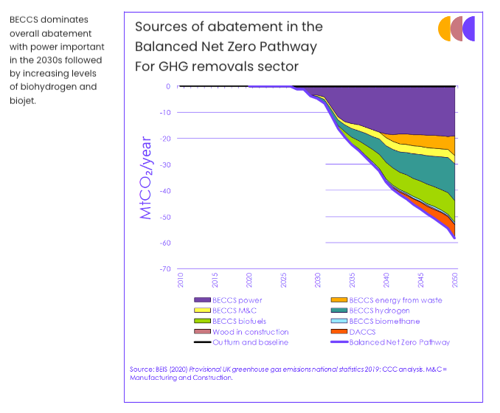Achieving net zero, or carbon neutrality, will mean that any carbon dioxide released into the atmosphere from human activity is balanced by an equivalent amount being removed. Of course, reducing carbon emissions in the first place is important but it is unrealistic to believe that there can be zero carbon emissions at all.
In the Intergovernmental Panel on Climate Change (IPCC) Special Report on Global Warming of 1.5°C, published in late 2018, almost all the pathways rely to some extent on carbon removal approaches.
In 2019, the UK became the world’s first major economy to adopt a legally binding target to reduce its greenhouse gas (GHG) emissions to net zero by 2050. In its October 2021 report HM Treasury made clear that carbon negative technology will be needed to balance hard to decarbonise parts of the economy such as heavy industry.
Types of greenhouse gas removal
The removal of carbon dioxide from the atmosphere falls into three categories: nature-based solutions, measures that aim to enhance natural processes, and technology-based solutions.
Nature-based solutions include afforestation (creating new forests) and reforestation (adding trees to damaged forests). The Climate Change Committee (CCC), which advises UK Government on the targets needed for climate change, says that UK forestry coverage needs to increase from 13% to at least 17% by 2050.
Enhanced natural processes include land management approaches to increase the carbon content in soil through modern farming methods - for example, by incorporating biochar (charcoal produced from biomass) in soils, where the carbon can remain stored for hundreds or thousands of years.
Technology solutions include BioEnergy (a form of renewable energy that is made from recently living materials) with Carbon Capture and Storage (BECCS) and Direct Air Capture of Carbon Dioxide with Storage (DACCS) where carbon dioxide is extracted directly from the atmosphere using chemical reagents and process heat, which potentially will come from low-carbon hydrogen. Both BECCS and DACCS routes rely on the development of UK carbon capture and storage infrastructure.
The CCC’s Sixth Carbon Budget forecasts that, under its Balanced Net Zero Pathway scenario, 58 Million tonnes of carbon dioxide per year (MtCO2/year) of greenhouse gas removals (GGRs) will be needed in 2050. This includes 53 MtCO2/year of negative emissions from BECCS in 2050 and 5 MtCO2/year from DACCS. This is in addition to nature-based carbon sinks of 39 MtCO2/year from UK land with examples including: carbon dioxide captured from afforestation, re-forestation, peatland restoration, on farm diversification (using trees) and planting of perennial energy crops. The CCC felt that other removal technologies such as biochar were too speculative to be included in the scenarios at that stage. For context, the UK’s total emissions are estimated at 417.1 million tonnes carbon dioxide equivalent (MtCO2e) in 2022.

Source: The Sixth Carbon Budget: The UK’s Path to Net Zero (Climate Change Committee)
The CCC scenarios for bioenergy assume that harvested sustainable biomass and biogenic waste (waste from living organisms) are used where they can best help to minimise overall GHG emissions. This was seen as essential because there will be limited supplies of bioenergy available to the UK that are truly low-carbon and do not compromise other aspects of sustainability (e.g. food production, water supplies and biodiversity).
Case Study:
ABSL’s pilot plant in Swindon is the first facility in the world to convert household waste into grid-quality biomethane.
By capturing the carbon dioxide within its process, ABSL is able to produce biofuels that are carbon negative. ABSL capture’s carbon pre-combustion, which is a low cost and efficient way to achieve the greenhouse gas removal.
The facility will take 8,000 tonnes per year of waste from the local area and convert it into 22GWh or 2.2 million cubic metres of biomethane, enough to heat 1,800 homes or fuel 75 HGVs for a year.
The plant will also produce 6,000 tonnes of carbon dioxide to be liquified for use in industry and 400 tonnes of vitrified ash for use as an aggregate.
As a comparison, it is estimated that the average car drives 7,600 miles per year in the UK, releasing approximately 1.68 tonnes of CO2 into the atmosphere each .
Case Study: Climeworks
Climeworks in Iceland has developed a DACCS facility called Mammoth. When fully operational Mammoth will have a carbon dioxide capture capacity of 36,000 tons per year.
Climeworks has ambitious scale-up plans for multi-million tonnes capacity in the 2030s and approximately a billion tonnes capacity by 2050.